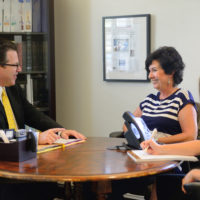Arkansas Department of Health v. Heidi Ahlborn
On Monday, May 1st, 2006 the United States Supreme Court set a new and helpful precedent in the resolution of liens in personal injury cases. The following article provides a summary of the case. A link to the actual text of the case follows the article. Solkoff Legal, P.A. does not seek representation in personal injury cases but we do a great deal of work helping trial lawyers and their clients. When a settlement or award is given to a Medicaid recipient, that person will lose his or her Medicaid health insurance and may well not qualify for any other insurance. Solkoff Legal, P.A. helps people to preserve their Medicaid while still getting the benefit of their settlement.
GOOD NEWS – AT LAST
The Impact of Arkansas v. Ahlborn on the Treatment of Medicaid Third Party Liability Liens
Rodolfo Suarez, Jr., Esquire and Daniel A. Terner, Esquire
May 8, 2006
——————————————————————————–
The unanimous decision of the Supreme Court of the United States, in Arkansas Dept. of Health and Human Services, et. al. v. Heidi Ahlborn, handed down on May 1st, 2006, will have a drastic impact on how personal injury attorneys handle Medicaid liens in their cases. Before this decision, a big concern for attorneys and their clients in whether or not to settle a personal injury case was the impact of the Medicaid liens. Generally speaking, in Florida, Medicaid has two types of liens which may affect a claim or lawsuit. The first is the Medicaid Third Party Liability Lien (TPL) and the second is the Medicaid Estate Recovery Unit Lien (ERU). The Supreme Court case, and therefore this discussion, only focuses on the TPL lien.
The Medicaid TPL lien is a lien asserted by the State against any recovery made in a claim where Medicaid paid any medical bills for care and treatment of injuries that were caused by the negligence of a third party, which gave rise to that claim. The typical third party liability lien arises when Medicaid claims they are entitled to reimbursement from the proceeds of a settlement or judgment, for any bills they paid relating to that claim. In the past, Medicaid has taken a very aggressive approach in recouping monies from settlements and/or judgments where they have paid medical bills on behalf of a Medicaid recipient, and that recipient later collected monies from the tortfeasor. In some instances, the monies recovered are far greater than the monies paid by Medicaid and therefore satisfaction of the Medicaid TPL lien is sometimes not an issue. In other cases, the monies recovered are far less than the monies paid by Medicaid. In these cases, Medicaid would apply an arcane “reduction formula” which will not be explained in detail here, but to oversimplify, it basically required a significant reduction in attorneys fees and allowable costs for the case and would then require payment of 50% of the balance in satisfaction of their TPL lien. It is in these types of cases which this new decision will have a dramatic impact.
Medicaid is required by the federal government to “ascertain the legal liability of third parties…to pay for [an individual benefits recipient’s] care and services available under the [State’s] plan; and to seek reimbursement for medical assistance to the extent of such legal liability,” As such, Medicaid took this as a directive to attempt to recuperate as much monies as it could from all aspects of a settlement or judgment, regardless of the amount of monies recovered and regardless of the allocation of the damages in the case. By way of example, under the old analysis, if Medicaid paid $50,000 in medical bills and a plaintiff recovered a total of $100,000 from the tortfeasor, Medicaid would seek recovery of their lien from the entire amount and the amount owed would be substantial. If not the full $50,000, it would be very close. Under the new case, however, there would be a dramatically different result, discussed further in this article. In your typical personal injury action, damages are sought against the at-fault party for, amongst other things, past medical expenses, loss of earnings, loss of earning capacity, future medical expenses as well as pain and suffering. In the past, Medicaid would attempt to, and was successful in recouping the monies they paid out for a Medicaid recipient from the entire amount of monies recovered. Ahlborn significantly changes this approach and has interpreted the federal anti-lien provisions as limiting Medicaid to asserting their lien only against the portion of the recovery that was related to payment of the past medical bills.
For instance, assuming in the example above, the personal injury case was resolved for $100,000 and the allocation of damages was $50,000 in pain and suffering damages, $25,000 in lost earning and lost earning capacity and $25,000 in past medical bills, Medicaid would only be allowed to assert their lien against the $25,000 in damages relating to the medical bills. In other words, where, in the past, they could collect close to their entire lien amount from the $100,000 settlement, under this scenario, they would be limited to asserting their $50,000 lien against only the $25,000 allocated for medical bills. Under this scenario, there are insufficient monies to pay for Medicaid’s lien. Clearly, if this is the case, on their very best day, Medicaid would only be entitled to recoup at most $25,000. In all likelihood, however, it would probably be significantly less once you reduce the amount collected by attorney’s fees and costs. (This example does not take into account the Medicaid reduction formula nor a reduction of the total amount owed for attorneys fees and costs. Likewise, at this point, Florida Medicaid has not yet determined how they will apply the reduction formula to arrive at a lien amount under these types of scenarios.) Needless to say, however, this will have a drastic impact on how much money is available to Medicaid in which to attach their TPL lien. Where they could previously attach their lien to the entire sum of monies collected, this case makes clear that the government is limited to only that portion of the monies collected relating to the medical bills.
What does this mean for the practicing personal injury attorney? Well, in cases where this issue exists, you will have to spend some time analyzing not only the hard damages (i.e. medical bills) but also the soft damages (i.e. pain and suffering). In working up the case, you want to try to obtain evidence as to these “soft” damages so that on the back end, when you are settling the case and dealing with the Medicaid TPL lien, you have support for your position. Once your case is ready to be resolved, the safest route would be to have a judicial determination of the allocation of damages in the case. You should provide Medicaid with “formal notice” of the hearing (by certified mail) and allow them an opportunity to object to the allocation of damages. This protects the practitioner and the client and affords Medicaid an opportunity to dispute the allocation of damages.
As a practical matter, the United States Supreme Court’s decision in Arkansas v. Ahlborn leaves more on the table for Plaintiffs, and this is good news indeed. For individuals with disabilities, in need of establishing a special needs plan to preserve their public benefit eligibility notwithstanding their receipt of settlement proceeds, the prospect of a smaller Medicaid lien (and, consequently, a greater net recovery) opens the door to the utilization of special needs planning options that might previously have been unavailable.
Solkoff Legal, P.A. represents injured parties through their trial lawyers using special needs trusts, qualified settlement funds, structured settlements, lien resolution strategies and other tools to help trial counsel resolve cases quickly and for more money. We are very pleased with the Ahlborn case and we wanted to get this information in your hands as soon as possible.











